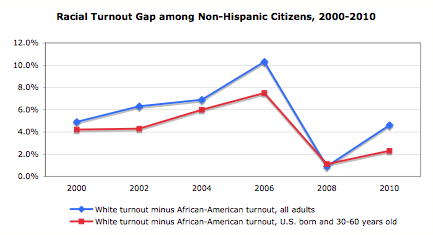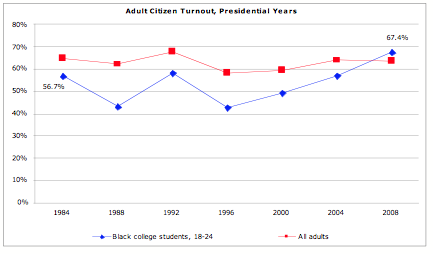Critical Consciousness Motivates Voting Among Poor and Working Class Youth
Matthew A. Diemer and Cheng-Hsien Li of Michigan State University have completed a new study, forthcoming in Child Development, that finds low-income youth are more apt to vote if they are engaged in political activism and influenced by friends and family. The research was funded by the National Academy of Education and a Spencer Foundation Read More >
A Closer Look at African-American Turnout

African-American turnout was remarkably high in 2008, and that fact received considerable attention. The turnout of African-Americans in 2010 was notably lower, and African-American turnout declined more than white turnout did between 2008 and 2010. According to the Census Current Population Survey, African-American* citizens over the age of 18 were 4.6 percentage points less likely Read More >
African-American College Students in 2008 and 2010

If you asked a casual observer of American politics who Barack Obama’s most ardent supporters were in 2008, they would likely have identified two groups: African-Americans and college students. So it’s no surprise that African-American college students turned out to vote in 2008 at their highest rate in decades: Turnout had been rising steadily for Read More >
Non-College Youth Voting in the States
In every state, young Americans without college experience – about half of the young population – were much less likely to vote in 2010 than their peers with college experience. Since educational attainment is a good measure of social class, low turnout by youths with no college experience makes our electorate less representative. This, however, doesn’t tell the Read More >
2010 College Student Voting – Part 1

We’ve shown how youth voting differs a great deal by education level. In April CIRCLE calculated the 2010 youth voter turnout using the newly-released Census Current Population Survey (CPS) data. The analysis included estimates by educational experience, showing dramatic differences. A 16 percentage point gap separates the turnout of those with college experience from those Read More >




